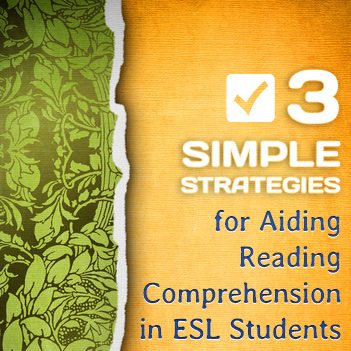Reading can be an intimidating piece of the English language puzzle. Large pages densely filled with words can turn students off before they even read a line.
You can help your students and their attitudes towards reading with any of these simple strategies aimed at aiding reading comprehension.

Slow Down & Predict
Most of the time when we read, we start at the beginning and make our way to the end. We may then think about what the author is trying to say to the reader, or we may think about how we feel about the writer’s assertions. When a student is reading in a second language, like your ESL learners are, an entire text is often too much to digest in one dose. A simple way around this is to give your students a moment to think about what they are reading as they work their way through the material.
-
1
Stop & Think
Whether you read the material to them, they read in a partner setting or they read independently, pause one third to one half of the way through the text and ask students to think. Use a prompting question, one that is open ended to get them thinking creatively. For example, if your students were reading a fictional piece, you may have them stop at the climax of the piece. Then ask them to think about how the main character might solve his or her problem. For a nonfiction piece, ask them to identify causes or effects for a particular situation (e.g. what causes reality television to be so popular) that relates to what they are reading.
Give them a few minutes to formulate their ideas. At this point, they may be thinking in their native languages or they may be thinking in English. Either way is fine, as long as students are digesting what they have read and thinking about the next step in the plot.
-
2
Share Your Ideas
Now, have your students share their ideas with a partner. They will need to speak in English at this point, especially if you have a multicultural classroom. When they do, they will convert the ideas that may have been abstract or articulated in their first language into logical English sentences. Partners can ask questions for clarification, and your students may decide to work together to create one larger answer to the question. They will also be getting conversation practice when they do, and that is always the goal for communicative language instruction.
-
3
Share with the Class
As a final step, have your students share their ideas with the class. Since they have practiced this idea sharing with their partners, they should have confidence to express themselves. This will give them additional conversation practice, and it will give them additional practice speaking publicly.

Teacher Think
Another way you can help your students increase their reading comprehension is by showing them how you read something. Taking a short passage, read aloud to your students, but as you do, take time to share your own thoughts as you read. When your students hear the questions you pose to yourself and the analysis you make as you read, they will begin to model their own thought patters while reading after yours. For example, if you were demonstrating a teacher think as you read “Jack and Jill” it might sound something like this. (Italics are your thoughts spoken aloud to your students.)
Jack and Jill went up the hill. I wonder how steep the hill is, and if they are going to be safe. To fetch a pail of water. So they are carrying something as they go, and they’ve got to bring this water back down. It is probably going to be heavy if the bucket is full. Jack fell down and broke his crown. Here is where he gets hurt. I wonder if he had the water already or if he is just clumsy. What is Jill going to do? And Jill came tumbling after. She is just like him. She should have known to be more careful after he fell, unless she didn’t see what happened to him. I still don’t know much about the hill itself, but it must have been somewhat dangerous.”

Tangible Reading
Though this method takes somewhat more preparation than the other two, it is valuable for the ESL student as she strives to understand the text that she reads. Having tangible objects that relate to the reading will give your students a sensory experience of the piece. If you are reading a fictional piece, bring in objects that appear in the story. For example, if you are reading “Jack and Jill” you could bring in a bucket, or take your students to a large hill to read the story. If you are reading a nonfiction piece, giving your students objects that relate to the reading and allowing them to touch and experience these items will increase their overall understanding of what they read. If you were going to read a piece on different types of weather, you could bring in a thermometer, a barometer or a weather map. Not only will these items give your students nonlinguistic information about the subject, they will help her connect the things she reads to tangible experiences she has had.
Reading does not have to be a big mystery for your ESL students.
With these simple strategies, you can increase their reading comprehension, their love for books, and their self confidence in their English abilities.
What other reading comprehension strategies have you found to be a success in your ESL class?
P.S. If you enjoyed this article, please help spread it by clicking one of those sharing buttons below. And if you are interested in more, you should follow our Facebook page where we share more about creative, non-boring ways to teach English.







